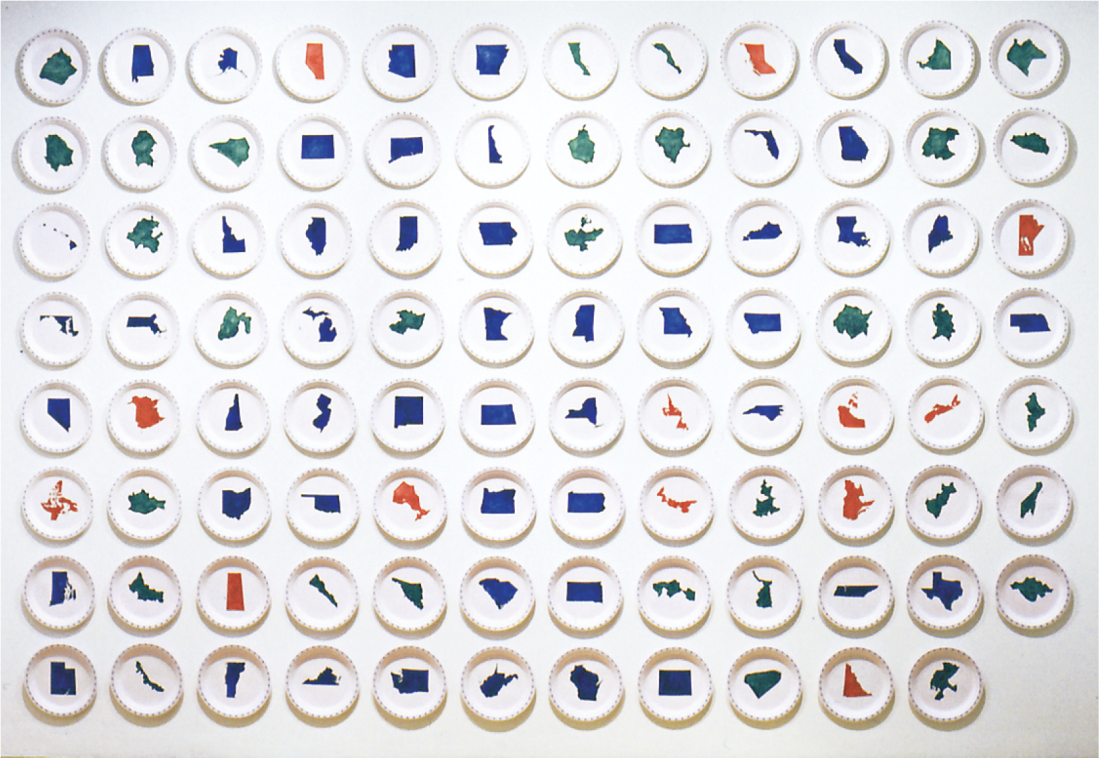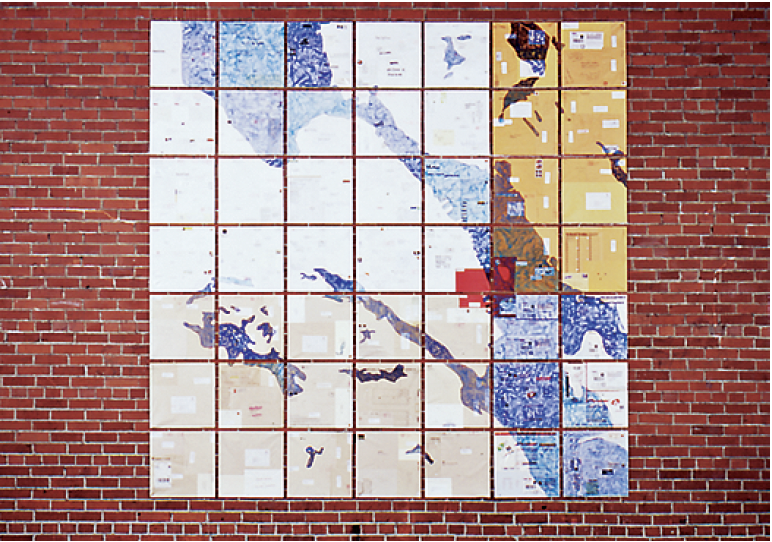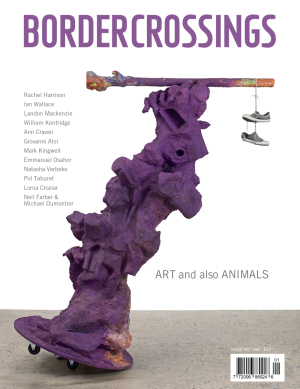Peter Dykhuis
Peter Dykhuis is a multitalented, multi-tasking sort of an artist. His prolific practice, squeezed into the spaces between life and work (he’s also the director of the Anna Leonowens Gallery at the Nova Scotia College of Art and Design) is dense and rich, textural and delicious.
“You Are Here” is the artist’s first solo show in his home city since 1997, and features drawings, paintings and installations made in the last decade. And though there’s an evident visual and thematic coherence, the show’s curator, Robin Metcalfe, doesn’t knock you over with it. Instead, the viewer is left to absorb the work by wandering through the gallery, building up a sense of meaning through meandering.
Dykhuis, it is clear, is an artist concerned with place, from the literal—rich and brightly hued depictions of surveillance maps in encaustic—to the more personal, mixed-media works created from culled to-do lists, notes and phone messages. The result is an exhibition of work deeply concerned with situational identity, while infused with a palpable low-level anxiety, inherent, perhaps, in 21st-century living.

Peter Dykhuis, State Dinner, 2005, watercolour on Royal Chinet paper plates, 26 cm diameter each, 290 x 440 cm. Photograph: Steve Farmer. Courtesy St. Mary’s University Art Gallery, Halifax, Nova Scotia.
Inspired by surveillance and military mapping technologies, the grid-like series of Radar Paintings, 1999–2003, depicts the weather systems over the Halifax International Airport—cloud systems floating ominously over the radar’s concentric circles, taking on a foreign presence in frenetic, coloured dashes. Made up of collected one-foot-square panels (an aesthetic and practical decision— stolen pockets of studio time make it more practical to focus on a controllable scale), the finished paintings, referencing the clouds, take on irregular geometric shapes, making the series at once orderly and jarring. Though Dykhuis was formerly a licensed recreational pilot, his interest in geography from above has little to do with the poetry of flight. In a Google Earth era where satellite images now provide a means of entertainment, these paintings are heavy with the more provocative and paranoid question of who is watching.
The mapping theme continues in the more playful piece, State Dinner, 2005, where 95 Royal Chinet paper plates, each bearing a watercolour painting of a Canadian province (in red), or American or Mexican state (in blue and green, respectively), are hung in tidy rows on the gallery wall. Instead of respecting territorial divisions, however, these geographic bits, each one rendered at the same scale, are offered up like NAFTAflavoured appetizers in alphabetical order. The trappings of political value removed, the provinces and states are reduced to studies in form and colour, a mosaic of red, blue and green mapped out on a disposable, commercial canvas.
Not unrelated is 50 World Views, 2004–2007, a collection of hand-drawn, pencil-crayon renderings of corporate logos, each a graphic depiction of the globe. With all identifying markers removed, the logos lose their commercial importance and are reduced, again, to aesthetic exercises, eerily familiar yet devoid of meaning.

Peter Dykhuis, You Are Here, 2005, encaustic on collaged used envelopes, 49 panels, 40 x 40 cm each, 295 x 295 cm installed.
In Pressure Today, an ongoing work, Dykhuis takes a more personal look at the notion of identity. Installed in one of the gallery’s smaller rooms, the piece is made up of envelopes, each addressed to the artist. Affixed to the walls in tidy rows that are configured to the dimensions of his home studio, the envelopes (one for each day since the initiation of the project in November 2004) address the artist in his various societal roles—as gallery director and artist, but also as taxpayer and consumer. Though that’s inherently interesting, each of the envelopes has then been uniformly adorned with a small line drawing of the day’s barometric pressure (the title refers directly to the daily feature in the Globe and Mail), turning each one into an obsessive-compulsive’s chronicling of the weather. Seen as a whole, the effect is overwhelming—each piece of mail seemingly demanding something of the addressee, each envelope just a marker of yet another day gone by.
The artist continues using the paraphernalia of his own life as the basis for Mixed Messages, 2006, a fascinating collection of notes brought together in a substantial collage that serves as the canvas for a large encaustic painting of a fighter jet. The notes, each addressing the artist in his various capacities (from “Daddy, there is toast for you in the plate cupboard” to “Peter, NSCAD press list updated”), are so fascinating that the jet, ominously painted in camouflage colours over top, becomes a secondary feature. We get so wrapped up in the minutiae of living—in this case, reading the demands of small, scrawled notes—that we fail to notice the actual painting, and have to step back from the work to really understand what it is we’re looking at.
“You Are Here” is a successful show—varied without being messy, airy without being vacant, and smart without smugness. And the title is apt: directly or indirectly, this is a show about place, routine and time. But it’s also about the subtle, low-level stress-cum-panic that is always lurking at the edges of modern life as we know it. ■
“You Are Here” was exhibited at Saint Mary’s University Art Gallery in Halifax from January 13 to March 18, 2007.
Meredith Dault is a freelance writer based in Halifax.

